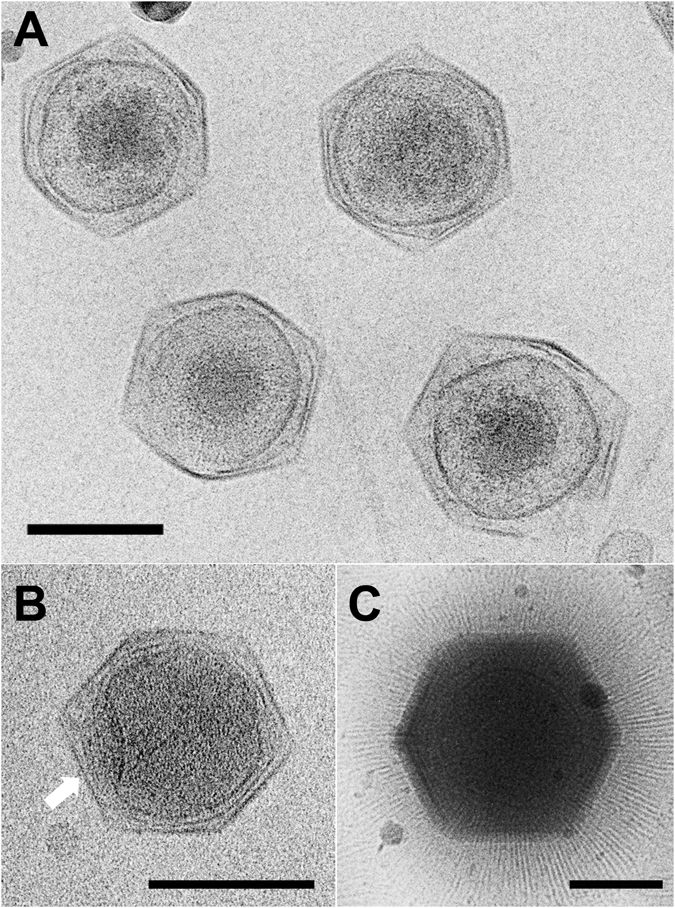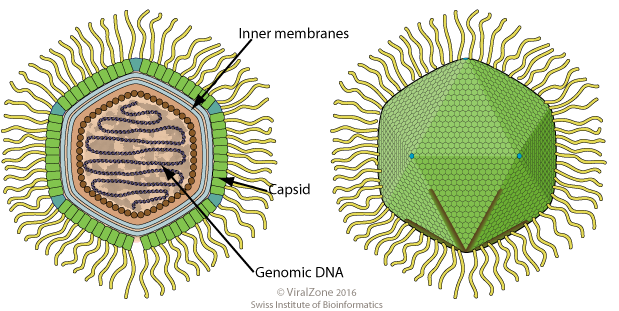|
Pithovirus
''Pithovirus'', first described in a 2014 paper, is a genus of giant virus known from two species, ''Pithovirus sibericum'', which infects amoebas and ''Pithovirus massiliensis''. It is a double-stranded DNA virus, and is a member of the nucleocytoplasmic large DNA viruses clade. The 2014 discovery was made when a viable specimen was found in a 30,000-year-old ice core harvested from permafrost in Siberia, Russia. Description The genus name ''Pithovirus'', a reference to large storage containers of ancient Greece known as pithoi, was chosen to describe the new species. A specimen of ''Pithovirus'' measures approximately 1.5 μm (1500 nm) in length and 0.5 μm (500 nm) in diameter, making it the largest virus yet found. It is 50% larger in size than the ''Pandoraviridae'', the previous largest-known viruses, and is larger than '' Ostreococcus'', the smallest eukaryotic cell, although ''Pandoravirus'' has the largest viral genome, containing 1.9 to 2.5 megabases ... [...More Info...] [...Related Items...] OR: [Wikipedia] [Google] [Baidu] |
Megavirales
''Nucleocytoviricota'' is a phylum of viruses. Members of the phylum are also known as the nucleocytoplasmic large DNA viruses (NCLDV), which serves as the basis of the name of the phylum with the suffix - for virus phylum. These viruses are referred to as nucleocytoplasmic because they are often able to replicate in both the host's cell nucleus and cytoplasm. The phylum is notable for containing the giant viruses. There are nine families of NCLDVs that all share certain genomic and structural characteristics; however, it is uncertain whether the similarities of the different families of this group have a common viral ancestor. One feature of this group is a large genome and the presence of many genes involved in DNA repair, DNA replication, transcription, and translation. Typically, viruses with smaller genomes do not contain genes for these processes. Most of the viruses in this family also replicate in both the host's nucleus and cytoplasm, thus the name nucleocytoplasmic. Th ... [...More Info...] [...Related Items...] OR: [Wikipedia] [Google] [Baidu] |
Nucleocytoplasmic Large DNA Viruses
''Nucleocytoviricota'' is a phylum of viruses. Members of the phylum are also known as the nucleocytoplasmic large DNA viruses (NCLDV), which serves as the basis of the name of the phylum with the suffix - for virus phylum. These viruses are referred to as nucleocytoplasmic because they are often able to replicate in both the host's cell nucleus and cytoplasm. The phylum is notable for containing the giant viruses. There are nine families of NCLDVs that all share certain genomic and structural characteristics; however, it is uncertain whether the similarities of the different families of this group have a common viral ancestor. One feature of this group is a large genome and the presence of many genes involved in DNA repair, DNA replication, transcription, and translation. Typically, viruses with smaller genomes do not contain genes for these processes. Most of the viruses in this family also replicate in both the host's nucleus and cytoplasm, thus the name nucleocytoplasmic. Th ... [...More Info...] [...Related Items...] OR: [Wikipedia] [Google] [Baidu] |
Permafrost
Permafrost is ground that continuously remains below 0 °C (32 °F) for two or more years, located on land or under the ocean. Most common in the Northern Hemisphere, around 15% of the Northern Hemisphere or 11% of the global surface is underlain by permafrost, with the total area of around 18 million km2. This includes substantial areas of Alaska, Greenland, Canada and Siberia. It can also be located on mountaintops in the Southern Hemisphere and beneath ice-free areas in the Antarctic. Permafrost does not have to be the first layer that is on the ground. It can be from an inch to several miles deep under the Earth's surface. It frequently occurs in ground ice, but it can also be present in non-porous bedrock. Permafrost is formed from ice holding various types of soil, sand, and rock in combination. Permafrost contains large amounts of biomass and decomposed biomass that has been stored as methane and carbon dioxide, making tundra soil a carbon sink. As global war ... [...More Info...] [...Related Items...] OR: [Wikipedia] [Google] [Baidu] |
Giant Virus
A giant virus, sometimes referred to as a girus, is a very large virus, some of which are larger than typical bacteria. All known giant viruses belong to the phylum ''Nucleocytoviricota''. Description While the exact criteria as defined in the scientific literature vary, giant viruses are generally described as viruses having large, pseudo- icosahedral capsids (200 to 400 nanometers in diameter) that may be surrounded by a thick (approximately 100 nm) layer of filamentous protein fibers. The viruses have large, double-stranded DNA genomes (300 to >1000 kilobasepairs) that encode a large contingent of genes (of the order of 1000 genes). The best characterized giant viruses are the phylogenetically related mimivirus and megavirus, which belong to the family ''Mimiviridae'' (aka ''Megaviridae''), and are distinguished by their large capsid diameters. Giant viruses from the deep ocean, terrestrial sources, and human patients contain genes encoding Cytochrome P450, cytochrome P45 ... [...More Info...] [...Related Items...] OR: [Wikipedia] [Google] [Baidu] |
Pandoraviridae
''Pandoraviridae'' is a family of double-stranded DNA viruses that infect amoebae. There is only one genus in this family: ''Pandoravirus''. Several species in this genus have been described, including ''Pandoravirus dulcis'', '' Pandoravirus salinus'' and ''Pandoravirus yedoma''. History The viruses were discovered in 2013. Description The viruses in this family are the second largest known virus (~1 micrometer) in capsid length, after ''Pithovirus'' (1.5 micrometer). ''Pandoravirus'' has the largest viral genome known, containing double-stranded DNA of 1.9 to 2.5 megabase A base pair (bp) is a fundamental unit of double-stranded nucleic acids consisting of two nucleobases bound to each other by hydrogen bonds. They form the building blocks of the DNA double helix and contribute to the folded structure of both D ... pairs. Evolution These viruses appear to be related to the phycodnaviruses. References {{Taxonbar, from=Q16987267 Nucleocytoplasmic large DNA viruses ... [...More Info...] [...Related Items...] OR: [Wikipedia] [Google] [Baidu] |
Pandoravirus
''Pandoravirus'' is a genus of giant virus, first discovered in 2013. It is the second largest in physical size of any known viral genus. Pandoraviruses have double stranded DNA genomes, with the largest genome size (2.5 million base pairs) of any known viral genus. Discovery The discovery of Pandoraviruses by a team of French scientists, led by husband and wife Jean-Michel Claverie and Chantal Abergel, was announced in a report in the journal ''Science'' in July 2013. Other scientists had previously observed the pandoravirus particles, but owing to their enormous size they were not expected to be viruses. Patrick Scheid, a parasitologist from the Central Institute of the Bundeswehr Medical Service in Koblenz, Germany, found one in 2008, in an amoeba living in the contact lens of a woman with keratitis. Its development within the amoebal host was documented extensively. Unlike in other cases with such giant viruses, the large particles within ''Acanthamoeba'' were not mistak ... [...More Info...] [...Related Items...] OR: [Wikipedia] [Google] [Baidu] |
Silene Stenophylla
''Silene stenophylla'' is a species of flowering plant in the family (biology), family Caryophyllaceae. Commonly called narrow-leafed campion, it is a species in the genus ''Silene''. It grows in the Arctic tundra of far eastern Siberia and the mountains of northern Japan. Frozen samples, estimated via radiocarbon dating to be around 32,000 years old, were discovered in the same area as current living specimens, and in 2012, a team of scientists successfully regenerated a plant from the samples. Habitat and description ''S. stenophylla'' grows in the Arctic tundra of far eastern Siberia and the mountains of northern Japan. It is typically tall, has narrow leaves, and a large calyx (flower), calyx. It blooms during the summer and has incised petals that are lilac, light pink, or white in color. It is a perennial that grows on stony cliffs and sandy shores. ''S. stenophylla'' is one of a few Beringian plant species that did not establish itself in North America. Etymology The bi ... [...More Info...] [...Related Items...] OR: [Wikipedia] [Google] [Baidu] |
Cytoplasm
In cell biology, the cytoplasm is all of the material within a eukaryotic cell, enclosed by the cell membrane, except for the cell nucleus. The material inside the nucleus and contained within the nuclear membrane is termed the nucleoplasm. The main components of the cytoplasm are cytosol (a gel-like substance), the organelles (the cell's internal sub-structures), and various cytoplasmic inclusions. The cytoplasm is about 80% water and is usually colorless. The submicroscopic ground cell substance or cytoplasmic matrix which remains after exclusion of the cell organelles and particles is groundplasm. It is the hyaloplasm of light microscopy, a highly complex, polyphasic system in which all resolvable cytoplasmic elements are suspended, including the larger organelles such as the ribosomes, mitochondria, the plant plastids, lipid droplets, and vacuoles. Most cellular activities take place within the cytoplasm, such as many metabolic pathways including glycolysis, and proces ... [...More Info...] [...Related Items...] OR: [Wikipedia] [Google] [Baidu] |
Aix-Marseille University
Aix-Marseille University (AMU; french: Aix-Marseille Université; formally incorporated as ''Université d'Aix-Marseille'') is a public research university located in the Provence region of southern France. It was founded in 1409 when Louis II of Anjou, Count of Provence, petitioned the Pisan Antipope Alexander V to establish the University of Provence, making it one of the oldest university-level institutions in France. The institution came into its current form following a reunification of the University of Provence, the University of the Mediterranean and Paul Cézanne University. The reunification became effective on 1 January 2012, resulting in the creation of the largest university in the French-speaking world, with about 80,000 students. AMU has the largest budget of any academic institution in the Francophone world, standing at €750 million. It is consistently ranked among the top 200 universities in the world and is ranked within the top 4 universities in France ac ... [...More Info...] [...Related Items...] OR: [Wikipedia] [Google] [Baidu] |
MRNA
In molecular biology, messenger ribonucleic acid (mRNA) is a single-stranded molecule of RNA that corresponds to the genetic sequence of a gene, and is read by a ribosome in the process of Protein biosynthesis, synthesizing a protein. mRNA is created during the process of Transcription (biology), transcription, where an enzyme (RNA polymerase) converts the gene into primary transcript mRNA (also known as pre-mRNA). This pre-mRNA usually still contains introns, regions that will not go on to code for the final amino acid sequence. These are removed in the process of RNA splicing, leaving only exons, regions that will encode the protein. This exon sequence constitutes mature mRNA. Mature mRNA is then read by the ribosome, and, utilising amino acids carried by transfer RNA (tRNA), the ribosome creates the protein. This process is known as Translation (biology), translation. All of these processes form part of the central dogma of molecular biology, which describes the flow of genet ... [...More Info...] [...Related Items...] OR: [Wikipedia] [Google] [Baidu] |
Marseilleviridae
''Marseilleviridae'' is a family of viruses first named in 2012. The genomes of these viruses are double-stranded DNA. Amoeba are often hosts, but there is evidence that they are found in humans as well. The family contains one genus and four species, two of which are unassigned to a genus. It is a member of the nucleocytoplasmic large DNA viruses ''Nucleocytoviricota'' is a phylum of viruses. Members of the phylum are also known as the nucleocytoplasmic large DNA viruses (NCLDV), which serves as the basis of the name of the phylum with the suffix - for virus phylum. These viruses are refe ... clade. Taxonomy The genus contains the following genera and species: *'' Marseillevirus'' **'' Marseillevirus marseillevirus'' **'' Senegalvirus marseillevirus'' *Species unassigned to a genus: **'' Lausannevirus'' **'' Tunisvirus'' Related Viruses Additional species have since been recognized. The first member of this family recognized has been named ''Acanthamoeba polyphaga marse ... [...More Info...] [...Related Items...] OR: [Wikipedia] [Google] [Baidu] |





